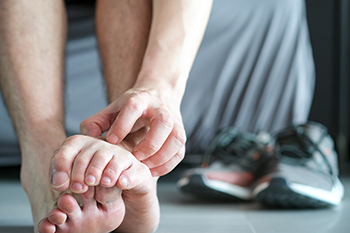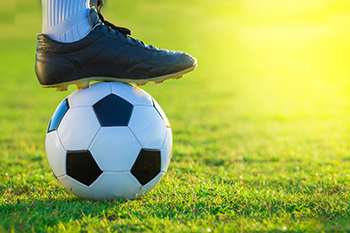(410) 764-7044
6506 Reisterstown Road, Baltimore
1205 York Road, Lutherville
6305 Belair Road, Baltimore
7809 Wise Avenue, Dundalk
August 2024
Athlete’s Foot Treatments

Athlete's foot is a fungal infection affecting the skin on the feet, often caused by the fungus tinea pedis. It thrives in warm and moist environments, making public showers, locker rooms, and swimming pools prime locations for infection. The condition typically causes itching, redness, and scaling between the toes, and can sometimes spread to the soles of the feet. The primary cause is exposure to the fungus, which can be contracted from contaminated surfaces or by sharing footwear. Individuals with sweaty feet or compromised immune systems are at higher risk. To address athlete's foot, start with antifungal treatments, available as creams, powders, or sprays. Keeping feet clean and dry is key and you should wash your feet daily, dry thoroughly, and change socks frequently. Wearing breathable, moisture-wicking socks and avoiding tight, non-ventilated shoes can also help. For persistent or severe cases of athlete's foot, it is suggested you schedule an appointment with a podiatrist for a more advanced treatment plan, which may include prescribed medication.
Athlete’s foot is an inconvenient condition that can be easily reduced with the proper treatment. If you have any concerns about your feet and ankles, contact one of our podiatrists from Plaza Podiatry. Our doctors will treat your foot and ankle needs.
Athlete’s Foot: The Sole Story
Athlete's foot, also known as tinea pedis, can be an extremely contagious foot infection. It is commonly contracted in public changing areas and bathrooms, dormitory style living quarters, around locker rooms and public swimming pools, or anywhere your feet often come into contact with other people.
Solutions to Combat Athlete’s Foot
- Hydrate your feet by using lotion
- Exfoliate
- Buff off nails
- Use of anti-fungal products
- Examine your feet and visit your doctor if any suspicious blisters or cuts develop
Athlete’s foot can cause many irritating symptoms such as dry and flaking skin, itching, and redness. Some more severe symptoms can include bleeding and cracked skin, intense itching and burning, and even pain when walking. In the worst cases, Athlete’s foot can cause blistering as well. Speak to your podiatrist for a better understanding of the different causes of Athlete’s foot, as well as help in determining which treatment options are best for you.
If you have any questions please feel free to contact our offices located in Baltimore, Lutherville, and Dundalk, MD . We offer the newest diagnostic and treatment technologies for all your foot and ankle needs.
Treatment for Hammertoes

Hammertoes, also known as claw toes or mallet toes, are deformities where one or more toes bend abnormally at the middle joint, resembling a hammer. This condition can range from mild to severe. In mild cases, toes may still be flexible and only slightly bent, causing minimal discomfort. Severe cases can involve rigid, painful toes that can lead to corns, calluses, and difficulty in walking. Hammertoes often result from wearing tight, narrow shoes that force the toes into a bent position. They can also be caused by muscle imbalances, arthritis, or genetic predisposition. Treatments vary based on severity. Mild cases can benefit from switching to roomier footwear, using orthotic devices, wearing splints, and performing toe exercises. Severe cases may require medical interventions such as corticosteroid injections or surgical correction. If you have severe pain from a hammertoe, it is suggested that you consult a podiatrist for the best ways to relieve discomfort and restore toe function.
Hammertoes can be a painful condition to live with. For more information, contact one of our podiatrists of Plaza Podiatry. Our doctors will answer any of your foot- and ankle-related questions.
Hammertoe
Hammertoe is a foot deformity that occurs due to an imbalance in the muscles, tendons, or ligaments that normally hold the toe straight. It can be caused by the type of shoes you wear, your foot structure, trauma, and certain disease processes.
Symptoms
- Painful and/or difficult toe movement
- Swelling
- Joint stiffness
- Calluses/Corns
- Physical deformity
Risk Factors
- Age – The risk of hammertoe increases with age
- Sex – Women are more likely to have hammertoe compared to men
- Toe Length – You are more likely to develop hammertoe if your second toe is longer than your big toe
- Certain Diseases – Arthritis and diabetes may make you more likely to develop hammertoe
Treatment
If you have hammertoe, you should change into a more comfortable shoe that provides enough room for your toes. Exercises such as picking up marbles may strengthen and stretch your toe muscles. Nevertheless, it is important to seek assistance from a podiatrist in order to determine the severity of your hammertoe and see which treatment option will work best for you.
If you have any questions, please feel free to contact our offices located in Baltimore, Lutherville, and Dundalk, MD . We offer the newest diagnostic and treatment technologies for all your foot care needs.
Types and Prevention of Ankle Injuries in Soccer

Ankle injuries are prevalent in soccer due to the sport's fast-paced, high-impact nature. Common injuries include sprains, where ligaments are stretched or torn, and strains, affecting the muscles or tendons around the ankle. Achilles tendonitis, an inflammation of the tendon that connects the calf to the heel, is also common. Prevention is key to avoiding these injuries. Wearing properly fitted soccer shoes with good ankle support helps reduce the risk of sprains and strains. Strengthening and flexibility exercises, such as ankle circles and calf stretches, can enhance ankle stability and resilience. Employing proper techniques, including correct foot positioning and avoiding excessive twisting movements, also contributes to injury prevention. Regular warm-ups and conditioning are vital for maintaining overall foot and ankle health during the rigorous demands of soccer. If you have suffered an ankle injury while playing soccer, it is suggested that you consult a podiatrist who can offer you treatment and injury prevention techniques.
Ankle and foot injuries are common among athletes and in many sports. They can be caused by several problems and may be potentially serious. If you are feeling pain or think you were injured in a sporting event or when exercising, consult with one of our podiatrists from Plaza Podiatry. Our doctors will assess your condition and provide you with quality foot and ankle treatment.
Common Injuries
The most common injuries that occur in sporting activities include:
- Achilles Tendonitis
- Achilles Tendon Rupture
- Ankle Sprains
- Broken Foot
- Plantar Fasciitis
- Stress Fractures
- Turf Toe
Symptoms
Symptoms vary depending upon the injury and in some cases, there may be no symptoms at all. However, in most cases, some form of symptom is experienced. Pain, aching, burning, bruising, tenderness, tightness or stiffness, sensation loss, difficulty moving, and swelling are the most common symptoms.
Treatment
Just as symptoms vary depending upon the injury, so do treatment options. A common treatment method is known as the RICE method. This method involves rest, applying ice, compression and elevating the afflicted foot or ankle. If the injury appears to be more serious, surgery might be required, such as arthroscopic or reconstructive surgery. Lastly, rehabilitation or therapy might be needed to gain full functionality in the afflicted area. Any discomfort experienced by an athlete must be evaluated by a licensed, reputable medical professional.
If you have any questions, please feel free to contact our offices located in Baltimore, Lutherville, and Dundalk, MD . We offer the newest diagnostic and treatment technologies for all your foot care needs.
Gout Pain Can Be Managed
Facts on Flat Feet Surgery

Flat feet surgery aims to correct the arch of the foot and alleviate associated symptoms like pain and difficulty walking. There are various types of surgical procedures, depending on the severity and underlying cause of the flat feet condition. Lateral column lengthening involves cutting and repositioning bones in the outer foot to create an arch. This procedure stabilizes the midfoot and improves weight distribution. Flexor digitorum longus transfer redirects a tendon from the toe to support the arch, enhancing its structure and function. Both surgeries aim to restore the foot's natural alignment and reduce strain on surrounding muscles and joints. Recovery typically involves immobilization to regain strength and mobility. Surgical intervention is considered when conservative treatments like orthotics and exercises fail to provide sufficient relief, aiming to improve foot function and quality of life for individuals with flat feet. If you are experiencing chronic pain from having flat feet, it is strongly suggested that you consult a podiatrist who can determine if flat foot surgery is right for you.
Foot surgery is sometimes necessary to treat a foot ailment. To learn more, contact one of our podiatrists of Plaza Podiatry. Our doctors will assist you with all of your foot and ankle needs.
When Is Surgery Necessary?
Foot and ankle surgery is generally reserved for cases in which less invasive, conservative procedures have failed to alleviate the problem. Some of the cases in which surgery may be necessary include:
- Removing foot deformities like bunions and bone spurs
- Severe arthritis that has caused bone issues
- Cosmetic reconstruction
What Types of Surgery Are There?
The type of surgery you receive will depend on the nature of the problem you have. Some of the possible surgeries include:
- Bunionectomy for painful bunions
- Surgical fusion for realignment of bones
- Neuropathy decompression surgery to treat nerve damage
Benefits of Surgery
Although surgery is usually a last resort, it can provide more complete pain relief compared to non-surgical methods and may allow you to finally resume full activity.
Surgical techniques have also become increasingly sophisticated. Techniques like endoscopic surgery allow for smaller incisions and faster recovery times.
If you have any questions please feel free to contact our offices located in Baltimore, Lutherville, and Dundalk, MD . We offer the newest diagnostic and treatment technologies for all your foot and ankle needs.





